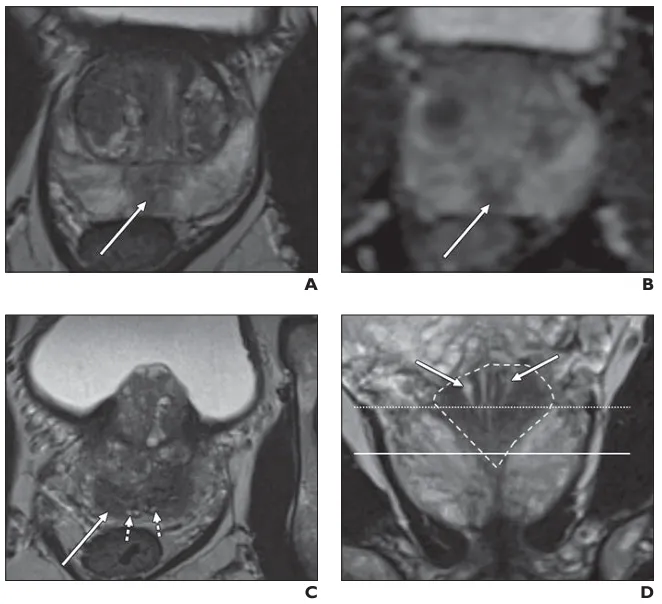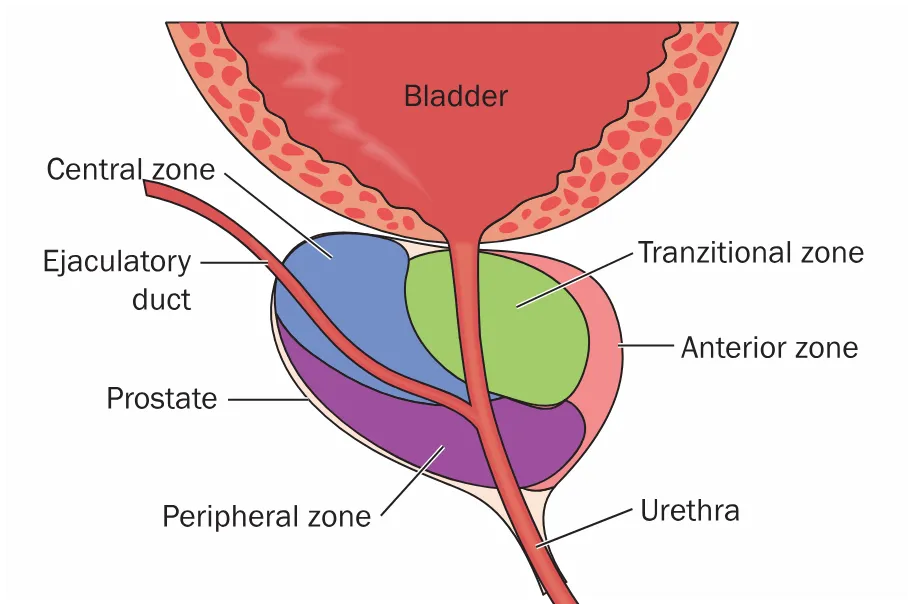What are the zones of the prostate? Do they influence the prognosis and treatment for prostate-related health issues?
A deeper understanding of the prostate gland can make it easier to understand overall prostate health and specific diagnoses. That knowledge can lead to more informed decision-making about treating prostate issues.
Both prostate cancer and benign prostatic hyperplasia (BPH) are significant concerns in men’s health. Each affects the zones of the prostate differently.
For example, BPH occurs in the transitional zone of the prostate. This causes difficulty with urination and can lead to more serious symptoms over time.
Prostate cancer can occur in all areas of the prostate. However, it’s most commonly found in the peripheral zone, with approximately 70% of such cancers originating there. This is due to the area containing the majority of prostatic glandular tissue.
Let’s look more closely at the prostate anatomy zones and how they relate to prostate cancer and BPH.
What are the Zones of the Prostate? How do They Relate to Prostate Cancer and BPH?

The prostate itself is a gland located beneath the bladder and in front of the rectum. It produces seminal fluid and helps to move semen through the urethra.
While the prostate itself is only roughly the size of a walnut in young men, it can be clearly divided into three zones. This division helps to segment the gland’s functions and aid in the diagnosis of prostate-related health issues. The zones of the prostate are:
1. Peripheral Zone of the Prostate
The peripheral zone of the prostate contains the majority of glandular tissue in this gland, about 70%. The peripheral zone surrounds much of the central zone, as well as part of the distal urethra.
As mentioned above, the peripheral zone is also the most common area where prostate cancer is found. This is due to the larger size of the peripheral zone relative to the other prostate zones.
A digital rectal exam (DRE) is a common early screening procedure for prostate cancer. A physician manually checks for irregularities in the prostate, which could indicate the presence of cancer. Because most of the peripheral zone sits closest to the rectum, this is the area that DREs focus on.
Much of the peripheral zone is close to one of two nerve bundles connected to the penis. This can complicate prostate cancer treatment. It’s an unfortunate anatomical situation.
Treatment can lead to nerve damage. Damage due to surgery — a radical prostatectomy — can cause impotence or erectile difficulty in a significant number of patients.
That’s true even when attentive “nerve-sparing” or perhaps more accurately phrased “attempted nerve-sparing” can be used on both sides of the prostate. In some cases, nerve-sparing should not be attempted due to the extent of cancerous growth. Erectile complications following surgery in these situations can be even more common.
Patients can present with both peripheral zone cancer as well as an enlarged prostate due to BPH. In these situations, traditional treatments for prostate cancer in the peripheral zone would not address BPH symptoms. Those symptoms are caused by the enlargement of the transitional zone, which we will cover in more depth in the next section.
Emerging treatments, such as laser focal therapy (LFT) and TULSA-PRO, can treat both issues. It’s possible to both treat cancer and reduce pressure on the bladder by ablating cancerous tissue and excess prostate growth. The minimally invasive nature of these procedures can help to minimize the risk of side effects and complications.
Prostate Laser Center is the first organization in the US to complete a prospective study on transrectal laser ablation for treating an enlarged prostate. Taking the lead in research is a crucial step in developing more effective treatment for BPH and prostate cancer.
2. Transitional Zone of the Prostate
The transitional zone, also known as the transition zone of the prostate, is normally a small area that surrounds the urethra but can grow quite large as a man ages. It has a lobe-like appearance, with one lobe on each side of the urethra.
The transitional zone continues to grow over time. Excess growth can cause difficulty urinating because the transitional zone applies increased pressure to the urethra. An enlarged transitional zone makes it more difficult for the urethra to open fully. The abnormal continued growth of this zone is a clear sign of BPH.
While BPH is not a life-threatening condition except for very severe instances, it can cause significant quality-of-life issues. Difficulty emptying the bladder, weak urination, and other symptoms can arise.
The peripheral zone is the most common site of prostate cancer. However, about 20% of prostate cancers occur in the transitional zone.
Cancer in the transitional zone is unique for a few reasons. It presents with larger total volumes and higher prostate-specific antigen (PSA) levels than cancers found in the peripheral zone. Without additional context, this could indicate more serious issues.
However, transitional zone cancers tend to be less aggressive. Cancer in this area is less likely to spread to surrounding areas. It also has a reduced tendency for recurrence. Your physician should take the location of a tumor in a specific zone into account when making a plan for treatment.
3. Central Zone of the Prostate
The central zone can be considered a large part of the base of the prostate gland. It also surrounds the ejaculatory ducts. These ducts pass through the prostate so fluid generated by the gland can be added to the semen and existing seminal fluid.
The central zone sits beneath the transitional zone and is itself mostly surrounded by the central prostate zone. Cancers in these zones are relatively rare. One study found that, among 1,703 cases and 2,494 tumors, just 2.5% originated in the central zone.
While the incidence is rare, prostate cancer found in the central zone can be more aggressive than those found in the other two zones. The same study found that:
- Central zone prostate cancer is more likely to grow beyond the prostate itself.
- Central zone prostate cancer presents a greater risk of reaching the seminal vesicles.
- Central zone prostate cancer cells are more likely to still be found following a surgical procedure to remove tumors.
Prostate cancer that extends beyond the gland itself is a sign of increased potential for recurrence.
When viewed via an MRI, the central zone can have a specific appearance that can be similar to that of cancer. Working with a skilled and experienced prostate radiologist and using a high-quality MRI for imaging are crucial in this regard. The complexities of accurate diagnosis increase in the central zone.
Closely Related but not a Prostate Zone: Anterior Fibromuscular Stroma
The anterior fibromuscular stroma is a band of tissue that sits in front of the transition zone of the prostate. It helps to maintain effective bladder pressure.
This area is connected to but distinct from the prostate. It’s not composed of glandular tissue, but fibromuscular tissue (as its name suggests).
The state of the anterior fibromuscular stroma can cause complications in diagnosing prostate cancer. This is because it can mimic key characteristics of cancerous activity in the prostate’s anterior region.
Prostate Zones and Treatment of Prostate Cancer and BPH
Prostate zones play a key role in differentiating the specific areas of the prostate. These divisions make it easier to describe the location of cancer or BPH.
Additionally, discoveries such as the increased aggressiveness of central zone cancer help to inform effective treatment. In terms of BPH, the foundational knowledge that it only occurs in the transitional zone similarly guides treatment decisions.
With traditional therapies such as radiation and surgery, the location of prostate cancer is not of great importance. That’s true as long as the cancer hasn’t expanded beyond the prostate itself.
For emerging treatments, like LFT and TULSA-PRO, the location of cancer within a specific zone isn’t as important as its distribution. If cancer is present in just one or a few areas and haven’t grown too large, LFT and TULSA-PRO can be effective choices for treatment.
As with any medical decision, understanding your options for dealing with prostate cancer and BPH is an important piece of the larger process. That includes the screening and evaluation process, as well as the actual treatment.
For prostate cancer, the use of advanced screening technology, such as multiparametric MRI (mpMRI), leads to improved visualization of cancer. It supports more accurate, targeted biopsies. Compared to the random sampling used in standard transrectal ultrasound-guided (TRUS) biopsy, it can produce more accurate results.
At Prostate Laser Center, we strongly believe in investigating promising treatment options and delivering proven ones to our patients. We help patients explore their options for treating prostate cancer as well as BPH.
Seeking treatment options for prostate cancer or BPH? Request a consultation today.
NOTE: The information provided on this website is general medical information and does not establish a physician-patient relationship. Please discuss your particular situation with a qualified medical professional.


